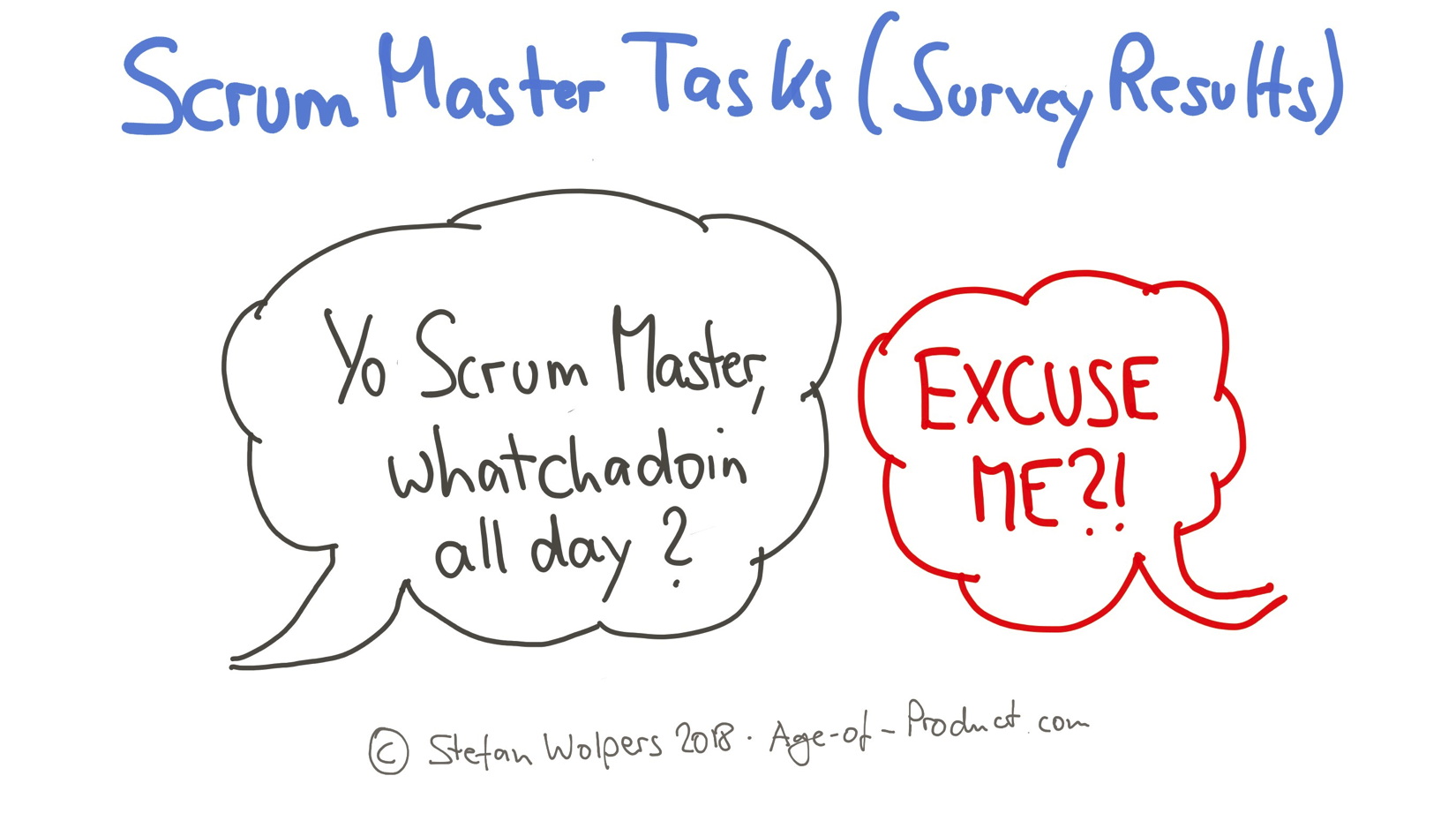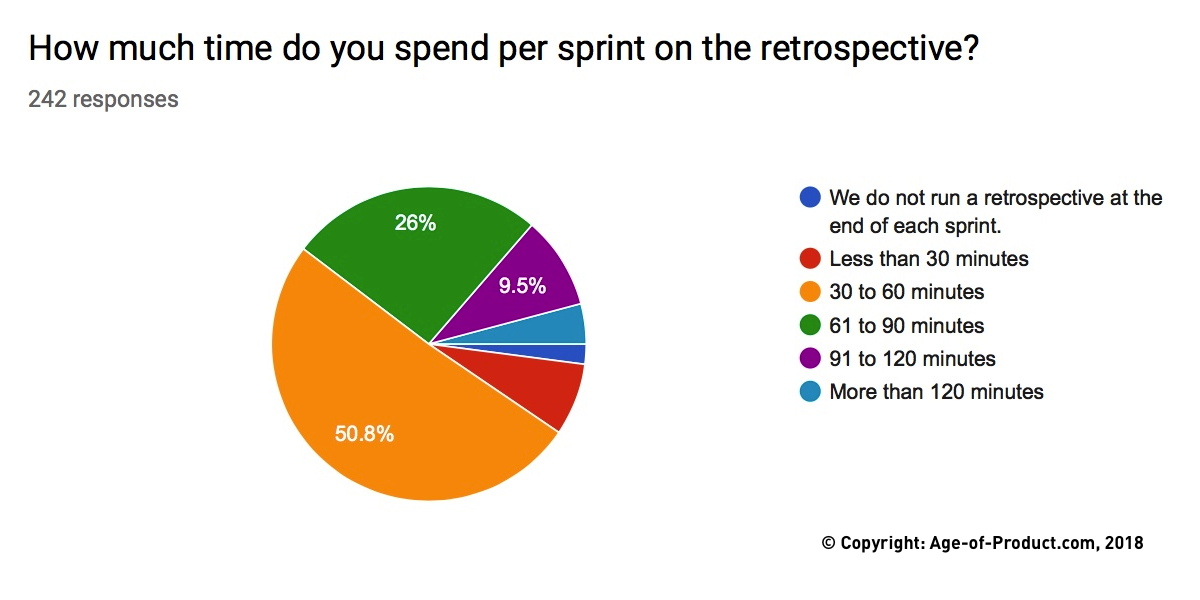I am sure many of you might agree to me with the statement that the Scrum Master is a crucial player on any Scrum teams, but what exactly does he or she do all day?
I am quite sure, there are a lot of people scratching their heads and thinking:
We all are working like bulls and what exactly is our Scrum Master doing?
That is why I wanted to share this Survey results to those folks. I hope this might give you a better insight on what your Scrum Masters might be doing all day.
This Survey was run by Stefan Wolpers in July 2018 and here is the gist of Survey:
No. of Participants: 261
No. of Responses: 242

Scrum Master Duties: Survey Results
The survey comprised of ten questions, two addressing technicalities (Sprint length and team size) and eight addressing the two most intensive work areas: Scrum ceremonies as well as education and training of teammates, stakeholders, and the Scrum Masters themselves.
Size of the Scrum Team
Question: How many people are on your Scrum Team?
Two-thirds of the respondents work on a Scrum Team of at least seven team members. Small Scrum Teams of four to five people make up less than 20% within the sample.

Sprint Length
Question: What is your Sprint length?
The vast majority of the respondents are members of Scrum Teams with a two-week Sprint. (81 percent.)

Product Backlog Refinement
Question: How much time do you spend weekly on Product Backlog refinement sessions?
More than half of all respondents spend no more than an hour per week on Product Backlog refinement sessions. Given that the Scrum Guide allocates up to 10 percent of the sprint to refining the Product Backlog, this means to be at the low end. Probably, the respondents are not participating the whole time in the Product Backlog refinement? (The survey was not designed to gain this kind of information.

Scrum Master Duties: Sprint Planning
Question: How much time do you spend per sprint on Sprint Planning?
The Sprint Planning is the most evenly distributed Scrum ceremony: the median value is around 75 minutes.

Daily Scrums
Question: How much time do you spend weekly on Daily Scrums?
Unsurprisingly, given the sizes of most Scrum teams in this survey, more than 40 percent of the teams spent between 12 and 18 minutes per Daily Scrum. On the other side of the spectrum, almost 30 percent of the teams get along with less than 5 minutes per Daily Scrum.

Scrum Master Duties: Sprint Review
Question: How much time do you spend per Sprint on the Sprint Review?
Almost haft of the Scrum Teams spends between 30 and 60 minutes on the Sprint Review. Interestingly, a fifth of the teams does not have Sprint Reviews or manages to get through them in less than 30 minutes.

Sprint Retrospectives
Question: How much time do you spend per Sprint on the Sprint Retrospective?
Half of the teams spent only 30 to 60 minutes on Retrospectives per Sprint, more than a third in the vicinity of 90 minutes.

Training and Support of Team Members
Question: How much time do you spend in total per week on training or supporting individual team members?
The answers to this question are wide-spread: more than 10 percent of all respondents spend at least 4 hours per week on coaching other team members. On the other side of the spectrum, 40 percent allocate less than an hour per week on coaching their teammates or do not do this at all.

Training and Support of Stakeholders
Question: How much time do you spend in total per week on training or supporting stakeholders from your organization?
A quarter of all respondents is not coaching stakeholders at all or allocates less than 30 minutes per week to this task. The rest allocates various amounts of time to stakeholder education, most commonly around an hour or two per week.

Learning
Question: How much time do you spend in total per week to learn from books, blogs, newsletters or from other Scrum Masters, for example, in communities?
Three-quarters of all Scrum Masters spend at least an hour a week on educating themselves, 30 % of them up to three hours a week.

Scrum Master Duties: Doing the Math
A typical Scrum team based on this survey has more than seven members and runs a two-week sprint.
On average, the team’s Scrum Master allocates his or her time roughly as follows, normalized to hours per week:
- Product Backlog refinement: 1.00 hours/week
- Sprint Planning: 0.75 hours/week
- Daily Scrum: 1.50 hours/week
- Sprint Review: 0.50 hours/week
- Sprint Retrospective: 0.75 hours/week
- Learning: 2.00 hours/week
- Training of teammates: 3.00 hours/week
- Training of stakeholders: 2.00 hours/week
If you do the math – the total amount of time spent on Scrum ceremonies, educating herself, or training teammates and stakeholders, respectively, is about 11.50 hours/week.
Learn what other activities Scrum Masters of a single team turn to as well in the next paragraph.
Additional Scrum Master Activities from Survey Participants
Here are some of the additional comments by survey participants:
“Preparing meetings, presentations, thinking through the habits of the team and prepare for the retro, self-reflection, writing internal blogs, preparing and executing a strategy/plan for organisational change towards agile. “
“I joined a team mid-flight where the PO was doing both PO and SM, and it’s very challenging to build trust with the team and to inspect and adapt. Some team members do not believe there is anything to improve, yet they never meet their sprint goal. “
“Other tasks are: working on impediments, preparation of the physical task board. “
“[I am] also spending a huge chunk of time doing the typical PM chores: project checklists, plans, etc. “
“The majority of my time is spent on helping remove impediments and team coordination with waterfall teams (all of our LOB teams are componentized). Also, I spend a good deal of time on reporting initiatives and internal “agile” initiatives. “
“[I am] working in LeSS with four teams in total, spending 3-4 [hours] [syncing] with other SMs and Teams. “
“[I am] working with a nimble startup trying to align with waterfall processes within a bank, trying to broaden [the] Agile adoption. “
“Depending on the sprint, I may spend a few hours preparing for [the] retro. “
“In particular, we have “corrupted” scrum to best feed the context of our company. I would not call it scrum, we are doing something based on it, we try to defend the values and principles, but the flow itself mutates based on the needs of the team. “
“[I am] liaising with other teams, external vendors. Aligning [the] team to [the] org process and tools. Metrics and reporting. “
“Gather Agile metrics and prepare reports for leadership. “
“As an Agile Coach, we spend more time on outside teams than we do with the direct team. Really, only one team for a Mid/Sr level SM? I call BS on that. “
“Training opportunities usually appear in regular Sprint Events, which I do not count separately from those events. Usually, training happens in bulk in one week, when I spend most of my time on training only. Then training occurs less. That is why I put a middle ground for training as if spread across several months. “
“I also observe a lot [of] people interactions and help with conflict resolution. “
“In my organization, we are still in [the] process of implementing scrum. The involvement of management and organization to do scrum is minimal. The organization wants to be agile, but not adopt agile practices (not yet by even doing all the ceremonies). Long way to go! “
“Some details about my support: it is about coaching people, ensuring proper implementation of ceremonies and adapting scrum framework to a non-IT environment. “
“I co-locate with my team. I listen to conversations in the team room to determine if things are going well, or need my help. As a [scrum master], you have to listen for what is NOT spoken and follow-up on those concerns just as much as what IS spoken. I have a lot of 1:1 conversation with team members and encourage them to follow-up on items as a result. This empowers the team member, and the team grows.”
Scrum Master Duties, Serving a Single Team — The Conclusion
As a conclusion to the Survey results published, Stefan Wolpers quoted the following:
I am afraid; we cannot answer that question once and for all given the non-representative nature of the survey. However, if you take into account what respondents also list in the ‘other tasks’ category, you will get a pretty good impression of the nature of the real-life Scrum Master position nowadays.
Survey Results: Scrum Master Problem Dealing was first published on Age-of-Product.com.
What do you guys think about it now ? If you are a Scrum Master, do you have anymore things to add into the list other than mentioned above ? If so you can drop it as a comment in the comment box below. Let’s have a truthful discussion.